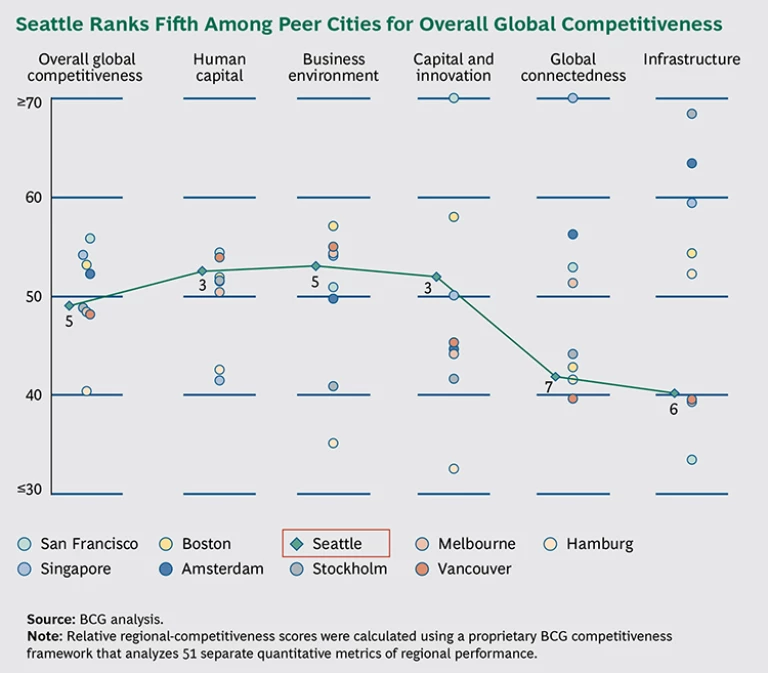The Seattle region has all the prerequisites to effectively compete on the global stage. Home to notable Fortune 500 companies—including Amazon, Boeing, Costco, Starbucks, and Microsoft—and boasting a historically robust innovation engine as well as striking natural beauty, Seattle is currently one of the fastest-growing metropolitan regions in the U.S.
Those winning attributes, however, will only take the region so far. Although Seattle’s position as a global business center has grown over the past decade, that progress has been driven more by favorable circumstance than by design. Seattle must follow the lead of Austin, Houston, Chicago, and other cities that are crafting focused strategies for raising their profiles—or risk being left behind.
To understand what such a plan would look like, The Boston Consulting Group, in partnership with the Seattle Chamber of Commerce, studied the global competitiveness of the greater Seattle region compared with eight peer regions. The work identified five factors that define a region’s competitiveness:
- Human capital (including education and overall livability)
- Business environment
- Capital and innovation
- Global connectedness
- Infrastructure
Benchmarking Seattle against similar urban regions, we found the region scores roughly in the middle of the pack. More important, the analysis identified five areas in which Seattle has significant room for improvement.
How Seattle Stacks Up
Seattle’s competitiveness was assessed against eight developed, dynamic, midsize city-regions: San Francisco, Boston, Vancouver, Singapore, Amsterdam, Stockholm, Hamburg, and Melbourne. Overall, Seattle ranks fifth, earning strong marks in human capital and innovation and showing weaknesses in infrastructure and global connectedness. (See the exhibit below.)
Based on that assessment, along with extensive interviews with 35 experts—including Seattle-area business leaders and leaders from peer regions—we identified five efforts that leaders in the Seattle region should make in order to address shortcomings. Bolster education. A region’s strength in human capital determines whether it can compete in the global marketplace and surmount future challenges. And while Seattle has one of the nation’s most educated populations, the region ranked near the bottom in our benchmarking when it comes to education. High school graduation rates varied between 67 and 96 percent—with that variability limiting the ability of students to go on to higher education and, ultimately, lowering the overall quality of the area workforce.
But workforce quality is not the only challenge. Although the University of Washington is consistently ranked as one of the world’s best research universities, area employers are experiencing a persistent and growing shortage in the availability of workers with STEM (science, technology, engineering, and mathematics) degrees. In fact, the net shortage of skilled workers in Washington State will reach 50,000 by 2017, according to an estimate by BCG and the Washington Roundtable, a regional public-policy organization.
The natural beauty of the Northwest may attract workers to the area—but to meet growing business needs, maintain competitiveness, and support high median incomes, Seattle must generate an increasing number of skilled workers.
Deepen the employer base. A broad and deep pool of employers is a critical element of a region’s overall business environment. And here Seattle did not emerge as a leader in our benchmarking. The Seattle region is highly dependent on a few employers: various estimates suggest that up to 175,000 Washington workers are directly employed by Boeing, Microsoft, University of Washington, and Amazon. And that doesn’t count the legions of high- and medium-paying jobs at suppliers and other businesses connected to these giants—as much as 20 percent of total employment in the region, according to some estimates.
Such employment statistics should be a source of both pride and concern for regional leaders. They highlight the tremendous growth and success of Seattle-region businesses. But they also show the region’s concentrated reliance on large employers. Seattle must take steps to encourage large companies to come to the region and remain in the region, while simultaneously fostering greater economic diversity by actively attracting and encouraging the growth of midsize businesses.
Fuel the innovation engine. Thanks to a culture of innovation—reflected in relatively high numbers of patents and startups—the Seattle region scored relatively well in our capital- and innovation-ecosystem benchmarking. Case in point: in the five years from 2007 through 2011, Seattle generated approximately three and a half startups per 100,000 inhabitants—second only to San Francisco among the benchmark cities.
But while the number of startups per capita is at competitive levels, there are signs of potential issues ahead. Over that same five-year period, the rate of growth in number of new Seattle startups slowed and is now falling behind domestic competitors such as Boston and New York. One possible reason is that access to capital in the Seattle region lags most of the regions we assessed. According to the National Venture Capital Association, Seattle received $890 million in venture capital funding in 2012—one-tenth of the amount secured by the San Francisco Bay Area and significantly behind Boston, New York, Los Angeles, and even San Diego. Seattle must actively encourage innovation through dedicated support for startup activity, partnership with the business community, and active outreach to venture capital funding sources.
Manage a global presence. Seattle clearly has advantages when it comes to competing globally, including its coastal location, historic role as a gateway to Asia, and the fact that it is home to a number of iconic global companies. And yet despite being located in one of the nation’s most trade-dependent states, the Seattle region clearly has work to do when it comes to building a global presence. In fact, Seattle ranked second to last in overall connectedness because of a below-average level of foreign direct investment and a limited number of globally connected firms. The region needs to make a concerted effort to rectify this, including developing a structured program that will attract foreign investment and businesses.
Strengthen the transportation infrastructure. When it comes to infrastructure, Seattle’s major challenge lies in its outmoded transportation network—an area in which the region ranked dead last in our benchmarking. Despite an expansive regional bus system and new light rail, only 8 percent of the growing population commutes by public transportation. The result is a heavy reliance on cars and mounting traffic congestion. So even with relatively short commuting distances, Seattle-area residents spend an average of 35 hours per year stuck in traffic. Long term, that congestion will limit Seattle’s ability to attract and retain both businesses and workers.
Cities such as San Francisco, Vancouver, and Singapore have invested in expansive regional-rail systems, while others, such as Amsterdam and Stockholm, encourage commuting by bicycle or on foot in order to limit the impact of congestion. Whether through regional rail, increased road capacity, or other investments, political leaders in the greater Seattle area must develop a cohesive regional transportation strategy to avoid growth-limiting gridlock.
The Seattle region is sophisticated, diverse, and vibrant, with the potential to become one of the strongest midsize economies in the world. However, getting there will require action. A clear vision for the future—backed by strong leadership and an engaged business community—is crucial. In particular, the effort must strengthen Seattle’s connections with global business and focus on ensuring a robust talent pipeline. Seattle’s future will be bright but only if business and government leaders choose to overcome emerging challenges to its competitiveness.









